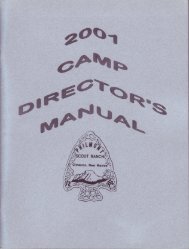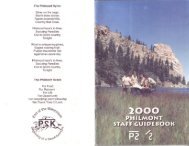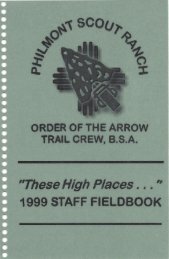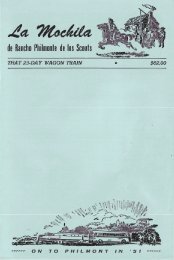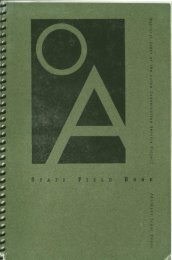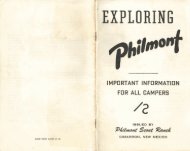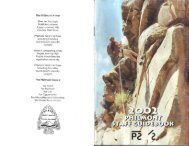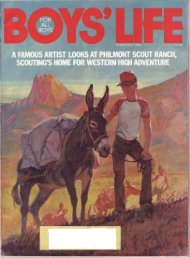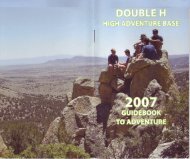philmont scout ranch
philmont scout ranch
philmont scout ranch
- No tags were found...
Create successful ePaper yourself
Turn your PDF publications into a flip-book with our unique Google optimized e-Paper software.
PHILMONT SCOUT RANCHDRIVER'S MANUAL AND GUIDETABLE OF CONTENTSSPECIAL REMINDERSIntroduction.............................i- - No doubt the most neglected point in caring for a car isoiling and greasing.- Waite Phillips- - Naturally a person will not be as considerate of a mudcovered car, as one nicely washed and polished. It isimportant that cars be washed and polished when needed,for this reason, in addition to the fact that the car bears ourtrademark and company name.- Waite Phillips- - No one has the right of way, which is only yielded andnever possessed.- Defensive DrivingDriver Education at Philmont ............... 1Conservation of Fuel and Vehicles .......... 1........................Philmont Policies 2Pre-Trip Inspection ...................... 4Pedestrians ............................ 5Philmont Driving Regulations ............... 5Special Tips & Rules for Philmont Roads ...... 8............................Automatics 11.........................4-Wheel Drive 1 1..................4-Speed Transmission 1 1.............Air Bags & Anti-Lock Brakes 12Drivers of Philmont Vehicles .............. 13
INTRODUCTIONDriving on Philmont is unique. The road, dr~ving demands,vehicle maintenance and safety are also unique.With the high cost of gasoline and service, it is imperativethat we avoid unnecessary trips and always try to combinetrips.This booklet is your Philmont Driver Manual and Guide.We have compiled tips and general information which willbe helpful to you as a driver. Please study the followingpages and accept what they offer in spirit as well as inpractice.THE PHILMONT MANAGEMENTDRIVER EDUCATION AT PHILMONTAll required drivers must attend a drivers' training course.If your job requires you to drive a Philmont Vehicle, aPhilmont driving permit will be issued if your driving record,participation in the training course and a road test (for firstyear Philmont drivers) are satisfactory. Staff membersemployed as drivers will be required to demonstrate theirdriving ability before receiving their driving permit.If a Philmont vehicle is assigned to you, you are the onlyone who can authorize another person to use it. Thisperson must have a Philmont Driving Permit.All safety rules that apply in the state of New Mexico andthe state in which you reside apply at Philmont. NewMexico Driver's Manuals are available upon requestthrough your supervisor.CONSERVATION OF FUEL AND VEHICLESThe increased cost of buying and operating vehicles is aserious budgeting concern to Philmont. Today's costmeans a larger part of every participant's fee is used forvehicle travel.With your cooperation and help, vehicular travel can bereduced to a minimum without reducing important service.This can be done with your help, cooperation andunderstanding.Tips to save gasoline:1. Plan ahead and schedule your trips.2. Always check with Logistics Services beforeleaving the CHQ area in order to pooltransportation, check out and be informed ofcurrent road policies and conditions.3. When the vehicle is stopped: turn off the ignition.Unnecessary idling is expensive.
4. If the distance is not great and the item isconvenient size, consider walking.5. Philmont vehicles are for business only and are notto be used for personal errands.You can help make this a year of conserving gasoline andvehicle operating costs.PHILMONT VEHICLE ANDMOTOR POOL POLICIESAcquaint yourself with the policies set by Philmontmanagement regulating Philmont vehicle use and motorpool service. Vehicle and driving policies apply to bothpermanent personnel and summer staff.1. Each driver is responsible for inspecting theassigned vehicle for safety. If anything is defective,take the vehicle to the motor pool for service. Oilchanges and other maintenance will be done by themotor pool personnel. Make an appointment whenthe key system indicates service is due.2. It will be the responsibility of the driver ordepartment to whom the vehicle is assigned to seethat the vehicle reaches the motor pod whenservice is due. For non-assiqned vehicles, it willbe the responsibilitv of the vehicle foreman tomake ins~ection and service at the wooer time.3. It is the responsibility of the vehicle foreman, or hishelper, to perform the inspection and work involvedas accurately and quickly as possible.NO VEHICLE SHALL LEAVE THE MOTOR POOL IF, INTHE OPINION OF THE DRIVER OR VEHICLEFOREMAN, IT IS UNSAFE FOR DRIVINGVehicle assignments will be made by the GeneralManager after consulting management staff abouttheir needs.To check an unassigned vehicle from the MotorPool, for business use, requires a phone call ornote from a Department Manager to the person incharge of the Mator Pool.All drivers are responsible for servicing gasoline,and oil levels and washing.Gasoline, oil, and service at the Motor Pool are forPhilmont owned vehicles only. Use for any othervehicles is prohibited.Report all defects or needed repairs on a vehicle tothe Motor Pool or supervisor so that necessaryrepairs can be completed. Failure to reportmaintenance needs will be considered impropertreatment of vehicle.All vehicles will be inspected weekly by the personor department they are assigned to.Personal use of Philmont vehicles is prohibited.A gate key is provided for each backcountryvehicle.ALWAYS:FASTEN AND ADJUST SEAT BELTLOOK BEFORE BACKINGDRIVE THE POSTED SPEED LIMIT
PRE-TRIP INSPECTIONItems that should be a part of your pre-trip inspectioninclude: (1) type and condition of vehicle; (2) roadconditions on which you will be operating; (3) yourcondition as a responsible driver; and (4) the followingcheck lists. The pre-trip vehicle inspection is essential fora safe and efficient trip.DANGEROUS VEHICLE CONDITIONSSmooth tiresToo little brake pedalGrabbing brakesLoose steering wheelNonfunctional windshield wipersImproper lights (includes signals)Broken glassDirty windshieldOverloaded vehicleDANGEROUS ROAD CONDITIONSGravel or chat on roads (chat is very slick when wet)Wet roads or pavementDust, fog or rainDusk and night drivingPedestrian, livestock and game on roadsWater barsSpeed bumpsNarrow roadsBlind curves, blind hillsDANGEROUS DRIVER CONDITIONSFatigueEmotional state (anger, worry, fear)Inexperience in backcountry drivingDefective hearing or eyesightUnder influence of alcohol, drugs or medicationInattentive to drivingCHECK DURING EACH REFUELINGGasolineOilWindshield wipersSteeringTiresWindsRieldLoadBrakesSpare TireJack & Lug WrenchTwo-way radio (if equipped)LightsEmergency lightsHornPEDESTRIANSPeople are the backbone of Philmont, vehicles only supportthem. All rules regarding pedestrian-vehicle travel apply atPhilmont. Pedestrians are asked to abide by these rules,however, in the backcountry, they may forget to use thebest judgment about vehicles.You, as a Philmont driver, must keep this in mind and do allyou can to protect the pedestrian. Yield the right of way topedestrians who are crossing the roadways, whether incrosswalks or not.In housing areas, or at the Training Center, special attentionshould be given to small children that may be playing on ornear the road. The 15 mph speed limit in these areas is themaximum and still may be too fast for many situation.PHILMONT DRIVING REGULATIONS1. Drive a Philmont vehicle only if you have PhilmontDriving Permit.
2. Do not drive a Philmont vehicle unless you and thevehicle foreman, or his assistant, have agreed that thevehicle is safe.3. Never, under any circumstances, drive your vehicleany place other than on established, approved roads.4. Administer primary first aid if an accident occurs, thennotify the Health Lodge.DO NOT MOVE the vehicle or vehicles involved, notifythe Vehicle Foreman or his assistant, and yourdepartment supervisor.5. Slow down when approaching visitors or vehicles inareas of special interest such as the buffalo pasture,Headquarters area or Rayado. Be prepared for theunexpected!6. Watch out for domestic stock and wildlife. Whenapproaching animals, slow down and prepare to stop.7. Leave each gate as you find it. If a gate was closed,make sure that you close it properly beforeproceeding.8. Observe all signs and speed limits at Philmont. Onewayroads have been developed in some areas forsafe flow of traffic and must be observed.9. Never carry passengers in the bed of a pickup, truckor RV. In case of a roll-over they are prone to severeinjury or death.10. Limit the number of passengers to the rated capacityof the vehicle. Each person must use a seat belt.Loads are to be secured so that they do notjeopardize the well-being of passengers.All rules and regulations established for operation ofPhilmont vehicles apply to use of personal vehicles.Unsafe operation can result in loss of drivingprivileges at Philmont.Back a vehicle only when absolutely necessary. Ifnecessary to back a vehicle, make sure you knowwhat is behind you before backing. If you havepeople with you, have one get out and assist you inbacking.Take special precautions when approaching aPhilmont bus and yield the right of way. Because ofsize, it cannot maneuver easily on the narrow roads.Slow down and stop when approaching a bus that isunloading or loading passengers.Securely fasten loads and load covers.When approaching horseback riders that areadjacent to the roadway, slow down and do not honkyour horn or drive in such a manner that might spookhorses. When approaching either horseback ridersor hiking groups crossing a roadway, stop and permitthem to continue to cross.When approaching livestock being herded by <strong>ranch</strong>personnel, stop and wait for the stock to pass youbefore proceeding.If you are not feeling well, or you are takingmedications that cause drowsiness, do not operate amotor vehicle.Travel after dark in the backcountry is limited toabsolute necessities (emergencies) and must beauthorized before departure by Administration andLogistics.
19. The improper use, improper treatment or carelesshandling of Philmont vehicles, in the judgment ofmanagement staff, will result in driving privileges ofPhilmont vehicles revoked.20. Exceeding the speed limit and reckless driving will notbe tolerated. Tickets received for a traffic violation arethe responsibility of the driver.21. Any accident involving a Philmont vehicle in which anydamage is sustained must be reported to the Directorof Program, department supervisor and the motor poolforeman, and the proper accident report must be filledout.SPECIAL TIPS AND RULESFOR PHILMONT ROADS1. In the event of a breakdown, please radio Logisticsgiving all the pertinent information on the problem, i.e.what equipment is broken, size of damaged tires, etc.This will enable the Motor Pool to bring the necessaryparts to the scene of the breakdown. If you mustleave the vehicle, do not take the keys with vou.2. Philmont has mountains, valleys, bumps, rocks, slickroads, narrow roads, blind curves and buses, trucks,pickups, cars, wagons and Scouts, leaders, staff,children, tourists, business people, wild game anddomestic livestock - all using Philmont roads. Beprepared to stop any place any time on a moment'snotice.3. Philmont roads do not all have the uniform grades,curves, banks, widths, etc. and most are surfacedwith loose gravel or natural soil. Keep this in mindwhen driving and reduce your speed to the pointwhere you are SURE you have your vehicle undercontrol.4. A pickup truck is much heavier in front than in therear and is inclined to fishtail.Ascending Steep Grade - Before climbing a steepgrade, the correct gear should be selected and theshift made to that gear. Also, if the vehicle isequipped with four-wheel drive and it will be needed,the shift should be made prior to starting up thegrade. If two or more vehicles are climbing a slope,they should always keep far enough apart to avoidaccidents should any vehicle get out of control andslide back down the slope.6. Descending Steep Slopes - When descending anysteep slope, drivers should always shift to the propergear and range before staring the descent. The gearthat is used in descending a road is usually the samegear used in ascending the same road.By keeping the vehicle in gear throughout thedescent, the braking effect of the engine is used andthus less use of the foot brake is required.7. Narrow Roads - On narrow mountain roads, a driverof a smaller vehicle should yield the right of way to alarge vehicle, such as a bus or stock truck, comingfrom the opposite direction. If the vehicles are equalin size, both drivers should stop and determinewhich has the better opportunity to back. Have apassenger or the other driver assist you in backing bydirecting you from behind. Also, on narrow mountainroads, keep to the right or come to a complete stopif necessary to let a vehicle from the oppositedirection safely pass you.
8. Fording Streams - Cheek to see if the stream isshallow enough so that the vehicle's electricalsystem will not get wet. Also, check to see that thebottom is solid and there are no submergedobstructions. Crossing should be made at theslowest possible speed and in the lowest gear.This will prevent splashing water on the electricalunits as well as preventing strain on the vehicle.Do not shift gears in the middle of the stream orstop.9. Watch out for fallen trees, rocks and landslides.Drive at a speed that you can make an emergencystop if necessary. Remove obstructions from theroad to prevent the possibility of someone elsehaving an accident.10. Road Clearance - Be sure you have adequateground clearance so the vehicle does not drag.11. Stopping on a Grade - If you must stop on a hill,turn the engine off, put a manual transmission inreverse and apply the parking brake. On downgrades turn your wheels toward the bank and onuphill grades turn them away from the bank foradded protection against a parking brake failure.Speed Limits - The maximum speed on Philmontroads from the highway to the bus turnarounds is30 mph. All backcountry roads beyond the busturnarounds have a posted maximum of 15 mph.Remember these are maximums. There will bemany conditions where these speeds are too fastfor the road surface or weather conditions.Reasonable and prudent is the rule to rememberand you will be checked by radar.AutomaticsAlthough the engine braking is not as great as with amanual transmission, you should use low range-4WDwhen descending, to limit the need for brake use. If youoverheat the brakes, they yiJ fail and you will have anaccident.4-Wheel DriveUse 4-wheel drive only when necessary.Use 4-wheel drive when driving through mud, snow, iceor sand which cannot be pulled with regular 2-wheeldrive or when ascending or descending a grade toosteep for 2-wheel drive. Engage the 4-wheel drive ona level section of road before it is needed.Always take the vehicle out of 4-wheel drive whentraveling on dry or hard surface roads.Philmont vehicles have several types of 4-wheel drive.Operate your vehicle according to the directions in theowner's manual. If you are not sure what to do, seethe Motor Pool Foreman.4-Speed TransmissionStart moving a loaded truck in first gearStart moving an empty truck in second gear, unless ona steep grade - then use first gear.You are encouraged to use the gears as a brakingdevice, but only to the extent that your speed and theRPM of your engine is no greater than if you wereapplying power uphill rather than braking downhill.
AIR BAGSWearing your safety belt during a crash helps reduceyour chance of hitting things inside the vehicle or beingejected from it. Air bags are "supplemental restraints"to the safety belts, but do not replace them.Air bags inflate with great force, faster than the blink ofan eye. If you're too close to an inflating air bag, itcould seriously injure you. Safety belts help keep youin position before and during a crash. The drivershould sit as far back as possible while still maintainingcontrol of the vehicle.If something is between an occupant and an air bag,the bag might not inflate properly or it might force theobject into that person. Don't put anything between anoccupant and an air bag.ANTI-LOCK BRAKES (ABS)Here's how anti-lock works: Let's say the road is wetand you're driving safely. Sudden!y an animal jumpsout in front of you. You slam on the brakes. Acomputer senses that wheels are slowing down. If oneof the wheels is about to stop rolling, the computer willseparately work the brakes at each front wheel and atthe rear wheels. The anti-lock system can change thebrake pressure faster than any driver could. Thecomputer is programmed to make the most of availabletire and road conditions. You can steer around theobstacle while braking hard. As you brake, yourcomputer keeps receiving updates on wheel speed andcontrols braking pressure accordingly.Remember: Anti-lock doesn't change the time youneed to get your foot up to the brake pedal or alwaysdecrease stopping distance.Usinn Anti-Lock BrakesDon't pump the brakes.Hold the brake pedal down and let anti-lock work foryou. You may feel the brakes vibrate, or you maynotice some noise, but this is normal.On vehicles with four-wheel drive, your anti-lockbrakes work at all times -- whether you are in twowheelor four-wheel drive.DRIVERS OF PHILMONT VEHICLESDrivers of Philmont vehicles must exercise safe drivingrules at all times. Unsafe practices cannot be tolerated.Lives are at stake.Violations will be handled in the following manner:TYPE OF OFFENSE THAT WILL BE CAUSE FORREPRIMAND OR ACTION:Leaving the scene of an accident with injuriesDriving while intoxicated or under the influence of liquoror drugs.Reckless driving - endangering lives and property.Operating an unsafe vehicle.Failure to submit accident report.Accident with fatality or injury.Driving on wrong side of road.Carrying a passenger in the bed of a pickup or truck.Allowing personnel to hang on to sides of vehicle.Speeding on highway or in backcountry.Not wearing seat belts.
lmproper passingFailure to observe traffic signals or signsFailure to yield the right of waylmproper or dangerous parkinglmproper backingFailure to give proper turn signalFailure to dim or turn on lightsFailure to yield right of way to pedestriansDriving without Philmont driver permitFailure to yield right of way in mountain drivingPersonal use of Philmont vehicles without properpermissionFailure to report vehicle defects for repairOverloading vehicle in excess of established capacitylmproper use of 4-wheel drive or 4-speedtransm~ss~onFailure to properly check vehicle out of motor poolBreaking any regulation not listed aboveDisciplinary action could result in one of the followingpenalties:1. Philmont driving permit revoked for 5 to 30 days.2. Philmont driving permit permanently revoked.3. Dismissal from Philmont employment.All Philmont personnel are required to report violations.We solicit your cooperation in making Philmont accidentfree.Each violation is to be reported to the immediatesupervisor who will review the nature of the violation withthe driver and discuss how it could have been prevented.A report will be made to the person's supervisor and thesupervisor's department head.Violations marked with a bullet will be reviewed by thePhilmont management team for appropriate action. Allother offenses will be handled by department supervisors.





